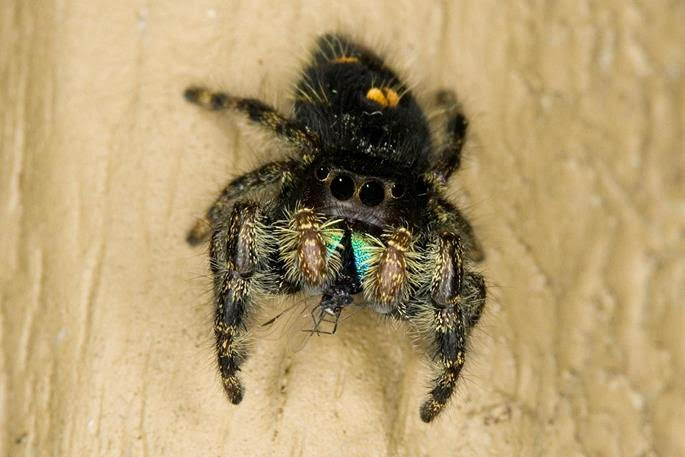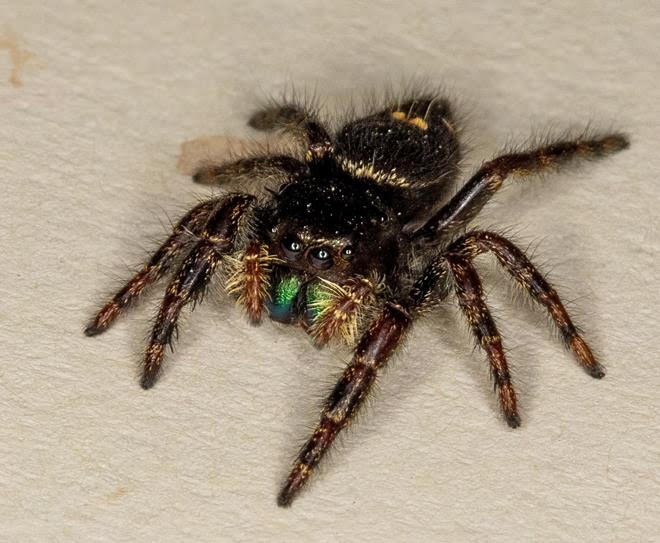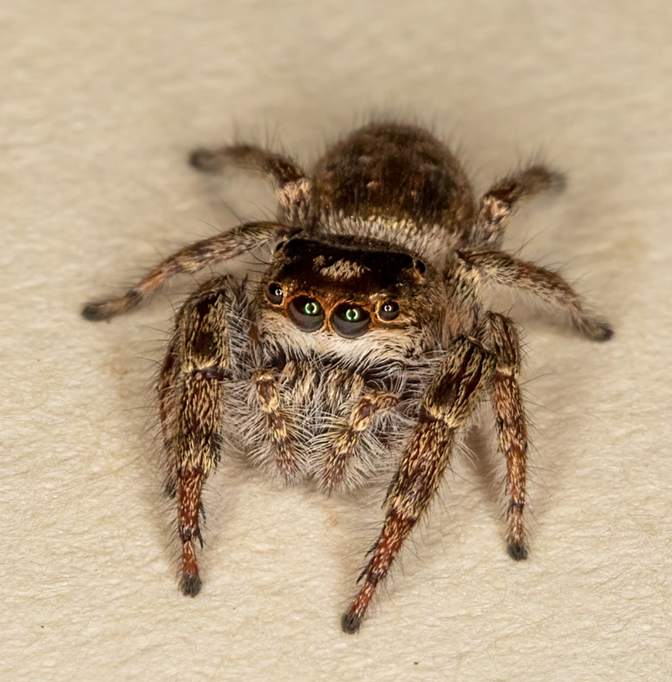The Secret Lives of Insects #10
- ACLT American Chestnut Land Trust
- Oct 8, 2021
- 4 min read

"Arachtober" 10th is International Jumping Spider Day!
By Judy Ferris, Master Naturalist & Guest Blogger
Do you Need a Warm, Fuzzy Hug?
Even folks who fear spiders must admit that this fuzzy-little jumping spider is cute as can be. She comes complete with 'horns', 8 eyes, and wears a tres chic fluffy sweater! Add to this her inquisitive engaging personality and she is the perfect ambassador for International Jumping Spider Day!
Though she looks ferocious, this little Canopy Jumping Spider is only 1/2 inch long. Look closely at her face and you will see the vivid green chelicirae (teeth) peeking out from the fur. Glowing, green teeth! Who could resist? Now stare deeply into the spider's eyes. On a large screen, your eyes begin to play tricks on you as you attempt to stare into all four eyes at once! Like most Jumping Spiders, the Canopy Jumper has 8 eyes arrayed around its head, 4 in front, 2 on the sides of the head, and 2 in the back. Jumpers have some of the best vision of any animal on the planet. Some species can even see in ultra-violet colors! Vision is key, since Jumping Spiders do not create webs to catch insects. Instead, they leap through the air to capture their prey.


Watch the video below to meet a cousin of the Bold Jumper – the Portia Spider of SE Asia and Australia. Portia Spiders have excellent vision and are intelligent hunters.
Most Jumping Spiders can jump about 20 times their body length. That may sound scary, but if you do the math, it comes out to a leap of about 12 inches. The over-achiever Bold Jumper, however, can leap
times its body length; a little over 2 feet.

https://www.youtube.com/watch?v=UDtlvZGmHYk
"Portia the Jumping Spider" -- 5 minutes. Beautifully filmed by the BBC. Video not playing? Click here: https://www.youtube.com/watch?v=UDtlvZGmHYk
You may have noticed that many of Portia's Jumping Spider cousins here in the United States seem to have an affinity for travel, or more likely, warm snuggly automobiles. They have a flair for appearing unexpectedly in your car as you zoom down the road! The devilish little arachnids revel in zipping across your dashboard, or even your windshield, at critical vehicular moments. Meanwhile, you attempt to focus on driving rather than speculating about the various places a spider could land should it choose to leap. Naturally, once the car is parked the spider vanishes into an inaccessible, dark hidey hole. Hopefully, it has disappeared beneath the dashboard, rather than somewhere in your clothing!

As they move about in their world, Jumping Spiders habitually leave a continuous trail of silk. Like leaving a trail of bread crumbs, this delicate line helps them with navigation. It also serves as a safety line and a drag line to control their landing when they leap. Perhaps most important of all, the trailing strand is also laced with pheromones which assist in finding a mate.Extensive study of Jumping Spider courtship reveals that male Jumping Spiders not only dance, but also 'sing' to entice females. Phase 1 in the courtship process is for the male to send a nice, soothing vibe to the female. 'Singing' is accomplished by rubbing together the spider's 2 body segments. This creates a vibration that travels through the ground to the female. In some species, the males thump their abdomens on the ground or tap their feet as well. Experiments have shown that when males are prevented from sending vibrations, the dissatisfied females are four times as likely to cannibalize the males. Ouch! (Heimbuch 2017) If singing and tapping doesn't work, it's time to escalate to Phase 2 - the Disco Dating Option. Think “Saturday Night Fever” for stylin' male spiders. Lots of leg waving, posing, color flashing, hair twitching, and fancy dance steps. All aimed at mesmerizing the female. The male's very life depends on a good performance. If all goes well, the male is able to carefully approach the female, transfer his sperm to her, and escape without becoming a snack. Australia is home to some of the planet's most exotic spiders, including the beautiful Peacock Jumping Spider. Click on the link below to view the elegant and potentially dangerous courtship ritual of a male Peacock Spider as it attempts to woo a judgmental mate. https://www.youtube.com/watch?v=5qkzwG2lLPc“Peacock Spiders, dance for your life!” Excellent video from BBC - 5 minutes. Video not playing? Click here:
Now that you have been thoroughly introduced to Jumping Spiders, what will you do if you find one of these creatures in your home? Should you kill it? Heck no! Spunky though they may be, these tiny spiders are far more likely to run away than to attack you. Their bite is not poisonous, although it may itch. Think of a Jumping Spider as a household helper; happiest when it's running around, eliminating unwanted insects from your home or garden. Though they may not be totally receptive to a warm, fuzzy hug, you
can
do Jumping Spiders a favor by simply ignoring them as they go about the endless business of pest control.
We'd Love To Get Your Feedback!
Could you spare a couple minutes to send us your thoughts about this blog series? We would really appreciate it as it will help us plan for future content! Thanks!



Comments